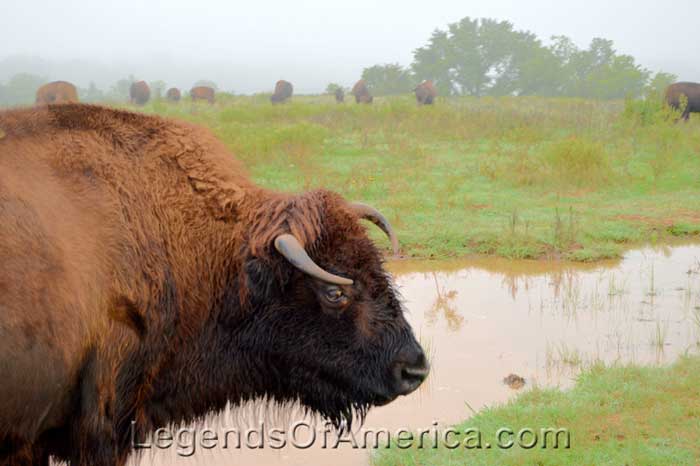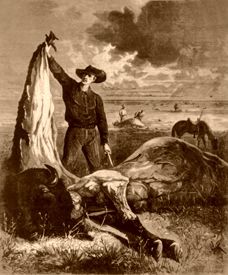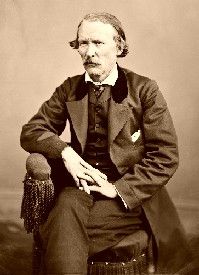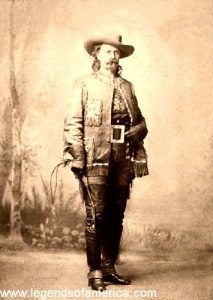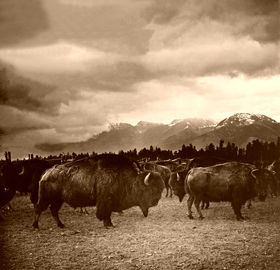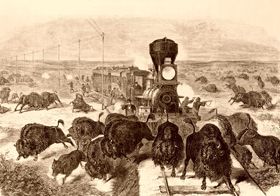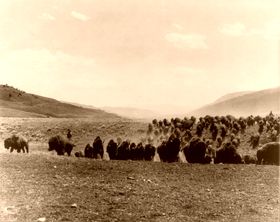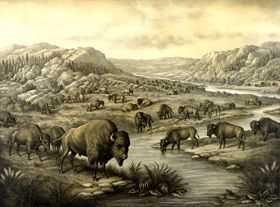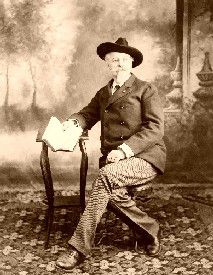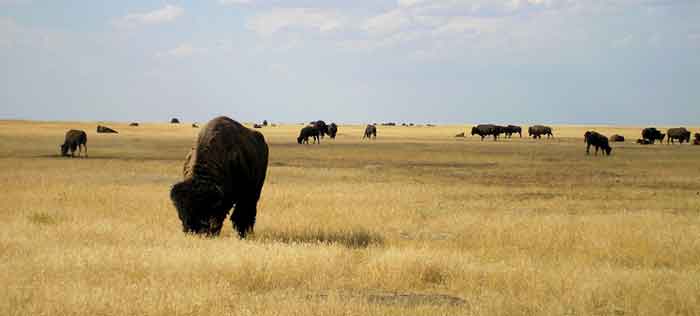By Colonel Henry Inman, 1897
The ancient range of the buffalo, according to history and tradition, once extended from the Alleghanies to the Rocky Mountains, embracing all that magnificent portion of North America known as the Mississippi valley; from the frozen lakes above to the “Tierras Calientes” of Mexico, far to the south.
It seems impossible, especially to those who have seen them, as numerous, apparently, as the sands of the seashore, feeding on the illimitable natural pastures of the Great Plains, that the buffalo should have become almost extinct.
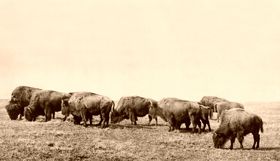
Buffalo on the Great Plains
When I look back only twenty-five years, and recall the fact that they roamed in immense numbers even then, as far east as Fort Harker, in Central Kansas, a little more than two hundred miles from the Missouri River, I ask myself, “Have they all disappeared?”
An idea may be formed of how many buffalo were killed from 1868 to 1881, a period of only thirteen years, during which time they were indiscriminately slaughtered for their hides. In Kansas alone there was paid out, between the dates specified, two million five hundred thousand dollars for their bones gathered on the prairies, to be utilized by the various carbon works of the country, principally in St. Louis. It required about one hundred carcasses to make one ton of bones, the price paid averaging eight dollars a ton; so the above-quoted enormous sum represented the skeletons of over thirty-one millions of buffalo. These figures may appear preposterous to readers not familiar with the Great Plains a third of a century ago; but to those who have seen the prairie black from horizon to horizon with the shaggy monsters, they are not so. In the autumn of 1868 I rode with Generals Sheridan, Custer, Sully, and others, for three consecutive days, through one continuous herd, which must have contained millions. In the spring of 1869 the train on the Kansas Pacific Railroad was delayed at a point between Forts Harker and Hays, from nine o’clock in the morning until five in the afternoon, in consequence of the passage of an immense herd of buffalo across the track. On each side of us, and to the west as far as we could see, our vision was only limited by the extended horizon of the flat prairie, and the whole vast area was black with the surging mass of frightened buffalo as they rushed onward to the south.
In 1868 the Union Pacific Railroad and its branch in Kansas was nearly completed across the plains to the foothills of the Rocky Mountains, the western limit of the buffalo range, and that year witnessed the beginning of the wholesale and wanton slaughter of the great ruminants, which ended only with their practical extinction seventeen years afterward. The causes of this hecatomb of animals on the Great Plains were the incursion of regular hunters into the region, for the hides of the buffalo, and the crowds of tourists who crossed the continent for the mere pleasure and novelty of the trip. The latter class heartlessly killed for the excitement of the new experience as they rode along in the cars at a low rate of speed, often never touching a particle of the flesh of their victims, or possessing themselves of a single robe. The former, numbering hundreds of old frontiersmen, all expert shots, with thousands of novices, the pioneer settlers on the public domain, just opened under the various land laws, from beyond the Platte River to far south of the Arkansas River, within transporting distance of two railroads, day after day for years made it a lucrative business to kill for the robes alone, a market for which had suddenly sprung up all over the country.
On either side of the track of the two lines of railroads running through Kansas and Nebraska, within a relatively short distance and for nearly their whole length, the most conspicuous objects in those days were the desiccated carcasses of the noble beasts that had been ruthlessly slaughtered by the thoughtless and excited passengers on their way across the continent. On the open prairie, too, miles away from the course of legitimate travel, in some places one could walk all day on the dead bodies of the buffalo killed by the hide-hunters, without stepping off them to the ground.
The best robes, in their relation to thickness of fur and luster, were those taken during the winter months, particularly February, at which period the maximum of density and beauty had been reached.
Then, notwithstanding the sudden and fitful variations of temperature incident to our mid-continent climate, the old hunters were especially active, and accepted unusual risks to procure as many of the coveted skins as possible.
A temporary camp would be established under the friendly shelter of some timbered stream, from which the hunters would radiate every morning, and return at night after an arduous day’s work, to smoke their pipes and relate their varied adventures around the fire of blazing logs.
Sometimes when far away from camp a blizzard would come down from the north in all its fury without ten minutes’ warning, and in a few seconds the air, full of blinding snow, precluded the possibility of finding their shelter, an attempt at which would only result in an aimless circular march on the prairie. On such occasions, to keep from perishing by the intense cold, they would kill a buffalo, and, taking out its viscera, creep inside the huge cavity, enough animal heat being retained until the storm had sufficiently abated for them to proceed with safety to their camp.
Early in March, 1867, a party of my friends, all old buffalo hunters, were camped in Paradise valley, then a famous rendezvous of the animals they were after. One day when out on the range stalking, and widely separated from each other, a terrible blizzard came up. Three of the hunters reached their camp without much difficulty, but he who was farthest away was fairly caught in it, and night overtaking him, he was compelled to resort to the method described in the preceding paragraph. Luckily, he soon came up with a superannuated bull that had been abandoned by the herd; so he killed him, took out his viscera and crawled inside the empty carcass, where he lay comparatively comfortable until morning broke, when the storm had passed over and the sun shone brightly. But when he attempted to get out, he found himself a prisoner, the immense ribs of the creature having frozen together, and locked him up as tightly as if he were in a cell. Fortunately, his companions, who were searching for him, and firing their rifles from time to time, heard him yell in response to the discharge of their pieces, and thus discovered and released him from the peculiar predicament into which he had fallen.
At another time, several years before the acquisition of New Mexico by the United States, two old trappers were far up on the Arkansas River near the Trail, in the foot-hills hunting buffalo, and they, as is generally the case, became separated. In an hour or two one of them killed a fat young cow, and, leaving his rifle on the ground, went up and commenced to skin her. While busily engaged in his work, he suddenly heard right behind him a suppressed snort, and looking around he saw to his dismay a monstrous grizzly ambling along in that animal’s characteristic gait, within a few feet of him.
In front, only a few rods away, there happened to be a clump of scrubby pines, and he incontinently made a break for them, climbing into the tallest in less time than it takes to tell of it. The bear deliberately ate a hearty meal off the juicy hams of the cow, so providentially fallen in his way, and when he had satiated himself, instead of going away, he quietly stretched himself alongside of the half-devoured carcass, and went to sleep, keeping one eye open, however, on the movements of the unlucky hunter whom he had corralled in the tree. In the early evening his partner came to the spot, and killed the impudent bear, that, being full of tender buffalo meat, was sluggish and unwary, and thus became an easy victim to the unerring rifle; when the unwilling prisoner came down from his perch in the pine, feeling sheepish enough. The last time I saw him he told me he still had the bear’s hide, which he religiously preserved as a memento of his foolishness in separating himself from his rifle, a thing he has never been guilty of before or since.
Kit Carson, when with Fremont on his first exploring expedition, while hunting for the command, at some point on the Arkansas River, left a buffalo which he had just killed and partly cut up, to pursue a large bull that came rushing by him alone. He chased his game for nearly a quarter of a mile, not being able, however, to gain on it rapidly, owing to the blown condition of his horse. Coming up at length to the side of the fleeing beast, Carson fired, but at the same instant his horse stepped into a prairie-dog hole, fell down and threw Kit fully fifteen feet over his head. The bullet struck the buffalo low under the shoulder, which only served to enrage him so that the next moment the infuriated animal was pursuing Kit, who, fortunately not much hurt, was able to run toward the river. It was a race for life now, Carson using his nimble legs to the utmost of their capacity, accelerated very much by the thundering, bellowing bull bringing up the rear.
For several minutes it was nip and tuck which should reach the stream first, but Kit got there by a scratch a little ahead. It was a big bend of the river, and the water was deep under the bank, but it was paradise compared with the hades plunging at his back; so Kit leaped into the water, trusting to Providence that the bull would not follow.
The trust was well placed, for the bull did not continue the pursuit, but stood on the bank and shook his head vehemently at the struggling hunter who had preferred deep waves to the horns of a dilemma on shore.
Kit swam around for some time, carefully guarded by the bull, until his position was observed by one of his companions, who attacked the belligerent animal successfully with a forty-four slug, and then Kit crawled out and–skinned the enemy!
He once killed five buffalo during a single race, and used but four balls, having dismounted and cut the bullet from the wound of the fourth, and thus continued the chase. He it was, too, who established his reputation as a famous hunter by shooting a buffalo cow during an impetuous race down a steep hill, discharging his rifle just as the animal was leaping on one of the low cedars peculiar to the region. The ball struck a vital spot, and the dead cow remained in the jagged branches. The Indians who were with him on that hunt looked upon the circumstance as something beyond their comprehension, and insisted that Kit should leave the carcass in the tree as “Big Medicine.” Katzatoa (Smoked Shield), a celebrated chief of the Kiowa many years ago, who was over seven feet tall, never mounted a horse when hunting the buffalo; he always ran after them on foot and killed them with his lance.
Two Lance, another famous chief, could shoot an arrow entirely through a buffalo while hunting on horseback. He accomplished this remarkable feat in the presence of the Grand Duke Alexis of Russia, who was under the care of Buffalo Bill, near Fort Hays, Kansas.
During one of Fremont’s expeditions, two of his chasseurs, named Archambeaux and La Jeunesse, had a curious adventure on a buffalo-hunt. One of them was mounted on a mule, the other on a horse; they came in sight of a large band of buffalo feeding upon the open prairie about a mile distant. The mule was not fleet enough, and the horse was too much fatigued with the day’s journey, to justify a race, and they concluded to approach the herd on foot.
Dismounting and securing the ends of their lariats in the ground, they made a slight detour, to take advantage of the wind, and crept stealthily in the direction of the game, approaching unperceived until within a few hundred yards. Some old bulls forming the outer picket guard slowly raised their heads and gazed long and dubiously at the strange objects, when, discovering that the intruders were not wolves, but two hunters, they gave a significant grunt, turned about as though on pivots, and in less than no time the whole herd–bulls, cows, and calves–were making the gravel fly over the prairie in fine style, leaving the hunters to their discomfiture. They had scarcely recovered from their surprise, when, to their great consternation, they beheld the whole company of the monsters, numbering several thousand, suddenly shape their course to where the riding animals were picketed. The charge of the stampeded buffalo was a magnificent one; for the buffalo, mistaking the horse and the mule for two of their own species, came down upon them like a tornado. A small cloud of dust arose for a moment over the spot where the hunter’s animals had been left; the black mass moved on with accelerated speed, and in a few seconds the horizon shut them all from view. The horse and mule, with all their trappings, saddles, bridles, and holsters, were never seen or heard of afterward.
Buffalo Bill, in less than eighteen months, while employed as hunter of the construction company of the Kansas Pacific Railroad, in 1867-68, killed nearly 5,000 buffalo, which were consumed by the 1200 men employed in track-laying. He tells in his autobiography of the following remarkable experience he had at one time with his favorite horse Brigham, on an impromptu buffalo hunt:
One day we were pushed for horses to work on our scrapers, so I hitched up Brigham, to see how he would work. He was not much used to that kind of labor, and I was about giving up the idea of making a work horse of him, when one of the men called to me that there were some coming over the hill. As there had been no buffalo seen anywhere in the vicinity of the camp for several days, we had become rather short of meat. I immediately told one of our men to hitch his horses to a wagon and follow me, as I was going out after the herd, and we would bring back some fresh meat for supper. I had no saddle, as mine had been left at camp a mile distant, so taking the harness from Brigham I mounted him bareback, and started out after the game, being armed with my celebrated buffalo killer Lucretia Borgia–a newly improved breech-loading needle-gun, which I had obtained from the government.
While I was riding toward the buffalo, I observed five horsemen coming out from the fort, who had evidently seen the buffalo from the post, and were going out for a chase. They proved to be some newly arrived officers in that part of the country, and when they came up closer I could see by the shoulder-straps that the senior was a captain, while the others were lieutenants.
“Hello! my friend,” sang out the captain; “I see you are after the same game we are.”
“Yes, sir; I saw those buffalo coming over the hill, and as we were about out of fresh meat I thought I would go and get some,” said I.
They scanned my cheap-looking outfit pretty closely, and as my horse was not very prepossessing in appearance, having on only a blind bridle, and otherwise looking like a work horse, they evidently considered me a green hand at hunting.
“Do you expect to catch those buffalo on that Gothic steed?” laughingly asked the captain.
“I hope so, by pushing on the reins hard enough,” was my reply.
“You’ll never catch them in the world, my fine fellow,” said the captain. “It requires a fast horse to overtake the animals on the prairie.”
“Does it?” asked I, as if I didn’t know it.
“Yes; but come along with us, as we are going to kill them more for pleasure than anything else. All we want are the tongues and a piece of tenderloin, and you may have all that is left,” said the generous man.
“I am much obliged to you, captain, and will follow you,” I replied.
There were eleven buffalo in the herd, and they were not more than a mile ahead of us. The officers dashed on as if they had a sure thing on killing them all before I could come up with them; but I had noticed that the herd was making toward the creek for water, and as I knew buffalo nature, I was perfectly aware that it would be difficult to turn them from their direct course. Thereupon, I started toward the creek to head them off, while the officers came up in the rear and gave chase.
The buffalo came rushing past me not a hundred yards distant, with the officers about three hundred yards in the rear. Now, thought I, is the time to “get my work in,” as they say; and I pulled off the blind bridle from my horse, who knew as well as I did that we were out after buffalo, as he was a trained hunter. The moment the bridle was off he started at the top of his speed, running in ahead of the officers, and with a few jumps he brought me alongside the rear buffalo. Raising old Lucretia Borgia to my shoulder, I fired, and killed the animal at the first shot. My horse then carried me alongside the next one, not ten feet away, and I dropped him at the next fire.
As soon as one of the buffalo would fall, Brigham would take me so close to the next that I could almost touch it with my gun. In this manner I killed the eleven buffalo with twelve shots; and as the last animal dropped, my horse stopped. I jumped off to the ground, knowing that he would not leave me–it must be remembered that I had been riding him without bridle, reins, or saddle–and, turning around as the party of astonished officers rode up, I said to them:
“Now, gentlemen, allow me to present to you all the tongues and tenderloins you wish from these buffalo.”
Captain Graham, for such I soon learned was his name, replied: “Well, I never saw the like before. Who under the sun are you, anyhow?”
“My name is Cody,” said I.
Captain Graham, who was considerable of a horseman, greatly admired Brigham, and said: “That horse of yours has running points.”
“Yes, sir; he has not only got the points, he is a runner and knows how to use the points,” said I.
“So I noticed,” said the captain.
They all finally dismounted, and we continued chatting for some little time upon the different subjects of horses, buffalo, hunting, and Indians. They felt a little sore at not getting a single shot at the buffalo; but the way I had killed them, they said, amply repaid them for their disappointment. They had read of such feats in books, but this was the first time they had ever seen anything of the kind with their own eyes. It was the first time, also, that they had ever witnessed or heard of a white man running buffalo on horseback without a saddle or bridle.
I told them that Brigham knew nearly as much about the business as I did, and if I had twenty bridles they would have been of no use to me, as he understood everything, and all that he expected of me was to do the shooting. It is a fact that Brigham would stop if a buffalo did not fall at the first fire, so as to give me a second chance; but if I did not kill the animal then, he would go on, as if to say, “You are no good, and I will not fool away my time by giving you more than two shots.” Brigham was the best horse I ever saw or owned for buffalo chasing. – (Buffalo Bill Cody)
At one time an old, experienced buffalo hunter was following at the heels of a small herd with that reckless rush to which in the excitement of the chase men abandon themselves, when a great bull just in front of him tumbled into a ravine. The rider’s horse fell also, throwing the old hunter over his head sprawling, but with strange accuracy right between the bull’s horns! The first to recover from the terrible shock and to regain his legs was the horse, which ran off with wonderful alacrity several miles before he stopped.
Next the bull rose, and shook himself with an astonished air, as if he would like to know “how that was done?” The hunter was on the great brute’s back, who, perhaps, took the affair as a good practical joke; but he was soon pitched to the ground, as the buffalo commenced to jump “stiff-legged,” and the latter, giving the hunter one lingering look, which he long remembered, with remarkable good nature ran off to join his companions. Had the bull been wounded, the rider would have been killed, as the then enraged animal would have gored and trampled him to death.
An officer of the old regular army told me many years ago that in crossing the plains a herd of buffalo were fired at by a twelve-pound howitzer, the ball of which wounded and stunned an immense bull.
Nevertheless, heedless of a hundred shots that had been fired at him, and of a bulldog belonging to one of the officers, which had fastened himself to his lips, the enraged beast charged upon the whole troop of dragoons, and tossed one of the horses like a feather. Bull, horse, and rider all fell in a heap. Before the dust cleared away, the trooper, who had hung for a moment to one of the bull’s horns by his waistband, crawled out safe, while the horse got a ball from a rifle through his neck while in the air and two great rips in his flank from the bull.
In 1839 Kit Carson and Hobbs were trapping with a party on the Arkansas River, not far from Bent’s Fort. Among the trappers was a green Irishman, named O’Neil, who was quite anxious to become proficient in hunting, and it was not long before he received his first lesson. Every man who went out of camp after game was expected to bring in “meat” of some kind. O’Neil said that he would agree to the terms, and was ready one evening to start out on his first hunt alone. He picked up his rifle and stalked after a small herd of buffalo in plain sight on the prairie not more than five or six hundred yards from camp.
All the trappers who were not engaged in setting their traps or cooking supper were watching O’Neil. Presently they heard the report of his rifle, and shortly after he came running into camp, bareheaded, without his gun, and with a buffalo bull close upon his heels; both going at full speed, and the Irishman shouting like a madman, “Here we come, by jabers. Stop us! For the love of God, stop us!”
Just as they came in among the tents, with the bull not more than six feet in the rear of O’Neil, who was frightened out of his wits and puffing like a locomotive, his foot caught in a tent-rope, and over he went into a puddle of water head foremost, and in his fall capsized several camp-kettles, some of which contained the trappers’ supper. But, the buffalo did not escape so easily; for Hobbs and Kit Carson jumped for their rifles, and dropped the animal before he had done any further damage.
The whole outfit laughed heartily at O’Neil when he got up out of the water, for a party of old trappers would show no mercy to any of their companions who met with a mishap of that character; but as he stood there with dripping clothes and face covered with mud, his mother-wit came to his relief and he declared he had accomplished the hunter’s task: “For sure,” said he, “haven’t I fetched the mate into camp? and there was no bargain whether it should be dead or alive!”
Upon Kit’s asking O’Neil where his gun was,
“Sure,” said he, “that’s more than I can tell you.”
Next morning Carson and Hobbs took up O’Neil’s tracks and the buffalos’, and after hunting an hour or so found the Irishman’s rifle, though he had little use for it afterward, as he preferred to cook and help around camp rather than expose his precious life fighting buffalo.
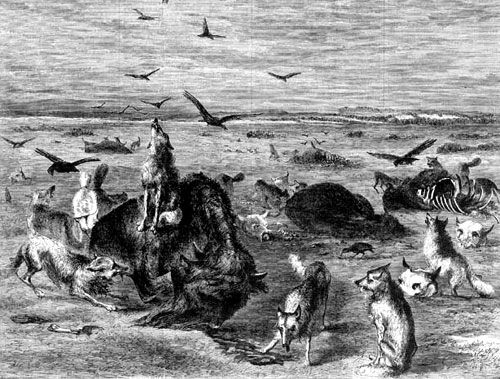
Buffalo Slaughtered
A great herd of buffalos on the plains in the early days, when one could approach near enough without disturbing it to quietly watch its organization and the apparent discipline which its leaders seemed to exact, was a very curious sight. Among the striking features of the spectacle was the apparently uniform manner in which the immense mass of shaggy animals moved; there was constancy of action indicating a degree of intelligence to be found only in the most intelligent of the brute creation.
Frequently the single herd was broken up into many smaller ones, that traveled relatively close together, each led by an independent master. Perhaps a few rods only marked the dividing-line between them, but it was always unmistakably plain, and each moved synchronously in the direction in which all were going.
he leadership of a herd was attained only by hard struggles for the place; once reached, however, the victor was immediately recognized, and kept his authority until some new aspirant overcame him, or he became superannuated and was driven out of the herd to meet his inevitable fate, a prey to those ghouls of the desert, the gray wolves.
In the event of a stampede, every animal of the separate, yet consolidated, herds rushed off together, as if they had all gone mad at once; for the buffalo, like the Texas steer, mule, or domestic horse, stampedes on the slightest provocation; frequently without any assignable cause. The simplest affair, sometimes, will start the whole herd; a prairie-dog barking at the entrance to his burrow, a shadow of one of themselves or that of a passing cloud, is sufficient to make them run for miles as if a real and dangerous enemy were at their heels.
Like an army, a herd of buffalo put out vedettes to give the alarm in case anything beyond the ordinary occurred. These sentinels were always to be seen in groups of four, five, or even six, at some distance from the main body.
When they perceived something approaching that the herd should beware of or get away from, they started on a run directly for the centre of the great mass of their peacefully grazing congeners.
Meanwhile, the young bulls were on duty as sentinels on the edge of the main herd watching the vedettes; the moment the latter made for the centre, the former raised their heads, and in the peculiar manner of their species gazed all around and sniffed the air as if they could smell both the direction and source of the impending danger. Should there be something which their instinct told them to guard against, the leader took his position in front, the cows and calves crowded in the centre, while the rest of the males gathered on the flanks and in the rear, indicating a gallantry that might be emulated at times by the genus homo.
Generally buffalo went to their drinking-places but once a day, and that late in the afternoon. Then they ambled along, following each other in single file, which accounts for the many trails on the plains, always ending at some stream or lake. They frequently traveled twenty or thirty miles for water, so the trails leading to it were often worn to the depth of a foot or more.
That curious depression so frequently seen on the Great Plains, called a buffalo-wallow, is caused in this wise: The huge animals paw and lick the salty, alkaline earth, and when once the sod is broken the loose dirt drifts away under the constant action of the wind. Then, year after year, through more pawing, licking, rolling, and wallowing by the animals, the wind wafts more of the soil away, and soon there is a considerable hole in the prairie.
Many an old trapper and hunter’s life has been saved by following a buffalo-trail when he was suffering from thirst. The buffalo-wallows retain usually a great quantity of water, and they have often saved the lives of whole companies of cavalry, both men and horses.
There was, however, a stranger and more wonderful spectacle to be seen every recurring spring during the reign of the buffalo, soon after the grass had started. There were circles trodden bare on the plains, thousands, yes, millions of them, which the early travelers, who did not divine their cause, called fairy-rings. From the first of April until the middle of May was the wet season; you could depend upon its recurrence almost as certainly as on the sun and moon rising at their proper time.
This was also the calving period of the buffalo, as they, unlike our domestic cattle, only rutted during a single month; consequently, the cows all calved during a certain time; this was the wet month, and as there were a great many gray wolves that roamed singly and in immense packs over the whole prairie region, the bulls, in their regular beats, kept guard over the cows while in the act of parturition, and drove the wolves away, walking in a ring around the females at a short distance, and thus forming the curious circles.
In every herd at each recurring season there were always ambitious young bulls that came to their majority, so to speak, and these were ever ready to test their claims for the leadership, so that it may be safely stated that a month rarely passed without a bloody battle between them for the supremacy; though, strangely enough, the struggle scarcely ever resulted in the death of either combatant.
Perhaps there is no animal in which maternal love is so wonderfully developed as the buffalo cow; she is as dangerous with a calf by her side as a she-grizzly with cubs, as all old mountaineers know.
The buffalo bull that has outlived his usefulness is one of the most pitiable objects in the whole range of natural history. Old age has probably been decided in the economy of buffalo life as the unpardonable sin. Abandoned to his fate, he may be discovered, in his dreary isolation, near some stream or lake, where it does not tax him too severely to find good grass; for he is now feeble, and exertion an impossibility. In this new stage of his existence he seems to have completely lost his courage. Frightened at his own shadow, or the rustling of a leaf, he is the very incarnation of nervousness and suspicion. Gregarious in his habits from birth, solitude, foreign to his whole nature, has changed him into a new creature; and his inherent terror of the most trivial things is intensified to such a degree that if a man were compelled to undergo such constant alarm, it would probably drive him insane in less than a week. Nobody ever saw one of these miserable and helplessly forlorn creatures dying a natural death, or ever heard of such an occurrence. The cowardly coyote and the gray wolf had already marked him for their own; and they rarely missed their calculations.
Riding suddenly to the top of a divide once with a party of friends in 1866, we saw standing below us in the valley an old buffalo bull, the very picture of despair. Surrounding him were seven gray wolves in the act of challenging him to mortal combat. The poor beast, undoubtedly realizing the utter hopelessness of his situation, had determined to die game. His great shaggy head, filled with burrs, was lowered to the ground as he confronted his would-be executioners; his tongue, black and parched, lolled out of his mouth, and he gave utterance at intervals to a suppressed roar.
The wolves were sitting on their haunches in a semi-circle immediately in front of the tortured beast, and every time that the fear-stricken buffalo would give vent to his hoarsely modulated groan, the wolves howled in concert in most mournful cadence.
After contemplating his antagonists for a few moments, the bull made a dash at the nearest wolf, tumbling him howling over the silent prairie; but while this diversion was going on in front, the remainder of the pack started for his hind legs, to hamstring him. Upon this the poor brute turned to the point of attack only to receive a repetition of it in the same vulnerable place by the wolves, who had as quickly turned also and fastened themselves on his heels again. His hind quarters now streamed with blood and he began to show signs of great physical weakness. He did not dare to lie down; that would have been instantly fatal. By this time he had killed three of the wolves or so maimed them that they were entirely out of the fight.
At this juncture the suffering animal was mercifully shot, and the wolves allowed to batten on his thin and tough carcass.
Often there are serious results growing out of a stampede, either by mules or a herd of buffalo. A portion of the Fifth United States Infantry had a narrow escape from a buffalo stampede on the Old Trail, in the early summer of 1866. General George A. Sykes, who commanded the Division of Regulars in the Army of the Potomac during the Civil War, was ordered to join his regiment, stationed in New Mexico, and was conducting a body of recruits, with their complement of officers, to fill up the decimated ranks of the army stationed at the various military posts, in far-off Greaser Land.
The command numbered nearly eight hundred, including the subaltern officers. These recruits, or the majority of them at least, were recruits in name only; they had seen service in many a hard campaign of the Rebellion.
Some, of course, were beardless youths just out of their teens, full of that martial ardor which induced so many young men of the nation to follow the drum on the remote plains and in the fastnesses of the Rocky Mountains, where the wily savages still held almost undisputed sway, and were a constant menace to the pioneer settlers.
One morning, when the command had just settled itself in careless repose on the short grass of the apparently interminable prairie at the first halt of the day’s march, a short distance beyond Fort Larned, a strange noise, like the low muttering of thunder below the horizon, greeted the ears of the little army.
All were startled by the ominous sound, unlike anything they had heard before on their dreary tour. The general ordered his scouts out to learn the cause; could it be Indians? Every eye was strained for something out of the ordinary. Even the horses of the officers and the mules of the supply-train were infected by something that seemed impending; they grew restless, stamped the earth, and vainly essayed to stampede, but were prevented by their hobbles and picket-pins.
Presently one of the scouts returned from over the divide, and reported to the general that an immense herd of buffalo was tearing down toward the Trail, and from the great clouds of dust they raised, which obscured the horizon, there must have been ten thousand of them. The roar wafted to the command, and which seemed so mysterious, was made by their hoofs as they rattled over the dry prairie.
The sound increased in volume rapidly, and soon a black, surging mass was discovered bearing right down on the Trail. Behind it could be seen a cavalcade of about five hundred Cheyenne, Comanche, and Kiowa, who had maddened the shaggy brutes, hoping to capture the train without an attack by forcing the frightened animals to overrun the command.
Luckily, something caused the herd to open before it reached the foot of the divide, and it passed in two masses, leaving the command between, not two hundred feet from either division of the infuriated beasts.
The rage of the savages was evident when they saw that their attempt to annihilate the troops had failed, and they rode off sullenly into the sand hills, as the number of soldiers was too great for them to think of charging.
Cody tells of a buffalo stampede which he witnessed in his youth on the plains, when he was a wagon-master. The caravan was on its way with government stores for the military posts in the mountains, and the wagons were hauled by oxen.
He said:
The country was alive with buffalo, and besides killing quite a number we had a rare day for sport. One morning we pulled out of camp, and the train was strung out to a considerable length along the Trail, which ran near the foot of the sand hills, two miles from the river. Between the road and the river we saw a large herd of buffalo grazing quietly, they having been down to the stream to drink. Just at this time we observed a party of returning Californians coming from the west. They, too, noticed the buffalo herd, and in another moment they were dashing down upon them, urging their horses to their greatest speed.
The buffalo herd stampeded at once, and broke down the sides of the hills; so hotly were they pursued by the hunters that about five hundred of them rushed pell-mell through our caravan, frightening both men and oxen. Some of the wagons were turned clear around and many of the terrified oxen attempted to run to the hills with the heavy wagons attached to them. Others were turned around so short that they broke the tongues off. Nearly all the teams got entangled in their gearing and became wild and unruly, so that the perplexed drivers were unable to manage them.
The buffalo, the cattle, and the men were soon running in every direction, and the excitement upset everybody and everything. Many of the oxen broke their yokes and stampeded. One big buffalo bull became entangled in one of the heavy wagon-chains, and it is a fact that in his desperate efforts to free himself, he not only snapped the strong chain in two, but broke the ox-yoke to which it was attached, and the last seen of him he was running toward the hills with it hanging from his horns.
Stampedes were a great source of profit to the Indians of the plains. The Comanche were particularly expert and daring in this kind of robbery. They even trained their horses to run from one point to another in expectation of the coming of the trains. When a camp was made that was nearly in range, they turned their trained animals loose, which at once flew across the prairie, passing through the herd and penetrating the very corrals of their victims. All of the picketed horses and mules would endeavor to follow these decoys, and were invariably led right into the haunts of the Indians, who easily secured them. Young horses and mules were easily frightened; and, in the confusion which generally ensued, great injury was frequently done to the runaways themselves.
At times when the herd was very large, the horses scattered over the prairie and were irrevocably lost; and such as did not become wild fell a prey to the wolves. That fate was very frequently the lot of stampeded horses bred in the States, they not having been trained by a prairie life to take care of themselves. Instead of stopping and bravely fighting off the blood-thirsty beasts, they would run. Then the whole pack were sure to leave the bolder animals and make for the runaways, which they seldom failed to overtake and dispatch.
On the Old Trail some years ago one of these stampedes occurred of a band of government horses, in which were several valuable animals. It was attended, however, with very little loss, through the courage and great exertion of the men who had them in charge; many were recovered, but none without having sustained injuries.
Hon. R. M. Wright, of Dodge City, Kansas, one of the pioneers in the days of the Santa Fe trade, and in the settlement of the State, has had many exciting experiences both with the savages of the Great Plains, and the buffalo. In relation to the habits of the latter, no man is better qualified to speak.
He was once owner of Fort Aubrey, a celebrated point on the Trail, but was compelled to abandon it on account of constant persecution by the Indians, or rather he was ordered to do so by the military authorities. While occupying the once famous landmark, in connection with others, had a contract to furnish hay to the government at Fort Lyon, seventy-five miles further west. His journal, which he kindly placed at my disposal, says:
While we were preparing to commence the work, a vast herd of buffalo stampeded through our range one night, and took off with them about half of our work cattle. The next day a stage-driver and conductor on the Overland Route told us they had seen a number of our oxen twenty-five miles east of Aubrey, and this information gave me an idea in which direction to hunt for the missing beasts. I immediately started after them, while my partner took those that remained and a few wagons and left with them for Fort Lyon.
Let me explain here that while the Indians were supposed to be peaceable, small war-parties of young men, who could not be controlled by their chiefs, were continually committing depredations, and the main body of savages themselves were very uneasy, and might be expected to break out any day. In consequence of this unsettled state of affairs, there had been a brisk movement among the United States troops stationed at the various military posts, a large number of whom were believed to be on the road from Denver to Fort Lyon.
I filled my saddle-bags with jerked buffalo, hardtack and ground coffee, and took with me a belt of cartridges, my rifle and six-shooter, a field-glass and my blankets, prepared for any emergency. The first day out, I found a few of the lost cattle, and placed them on the river-bottom, which I continued to do as fast as I recovered them, for a distance of about eighty-five miles down the Arkansas River. There I met a wagon-train, the drivers of which told me that I would find several more of my oxen with a train that had arrived at the Cimarron crossing the day before. I came up with this train in eight or ten hours’ travel south of the river, got my cattle, and started next morning for home.
I picked up those I had left on the Arkansas River as I went along, and after having made a very hard day’s travel, about sundown I concluded I would go into camp. I had only fairly halted when the oxen began to drop down, so completely tired out were they, as I believed. Just as it was growing dark, I happened to look toward the west, and I saw several fires on a big island, near what was called “The Lone Tree,” about a mile from where I had determined to remain for the night.
Thinking the fires were those of the soldiers that I had heard were on the road from Denver, and anticipating and longing for a cup of good coffee, as I had had none for five days, knowing, too, that the troops would be full of news, I felt good and determined to go over to their camp.
The Arkansas River was low, but the banks steep, with high, rank grass growing to the very water’s edge. I found a buffalo-trail cut through the deep bank, narrow and precipitous, and down this I went, arriving in a short time within a little distance of my supposed soldiers’ camp. When I had reached the middle of another deep cut in the bank, I looked across to the island, and, great Caesar! saw a hundred little fires, around which an aggregation of a thousand Indians were huddled!
I slid backwards off my horse, and by dint of great exertion, worked him up the river-bank as quietly and quickly as possible, then led him gently away out on the prairie. My first impulse was not to go back to the cattle; but as we needed them very badly, I concluded to return, put them all on their feet, and light out mighty lively, without making any noise.
I started them, and, oh dear! I was afraid to tread upon a weed, lest it would snap and bring the Indians down on my trail. Until I had put several miles between them and me, I could not rest easy for a moment. Tired as I was, tired as were both my horse and the cattle, I drove them twenty-five miles before
I halted.
Then daylight was upon me. I was at what is known as Chouteau’s Island, a once famous place in the days of the Old Santa Fe Trail.
Of course, I had to let the oxen and my horse rest and fill themselves until the afternoon, and I lay down, and fell asleep, but did not sleep long, as I thought it dangerous to remain too near the cattle. I rose and walked up a big, dry sand creek that opened into the river, and after I had ascended it for a couple of miles, found the banks very steep; in fact, they rose to a height of eighteen or twenty feet, and were sharply cut up by narrow trails made by the buffalo.
The whole face of the earth was covered by buffalo, and they were slowly grazing toward the Arkansas River. All at once they became frightened at something, and stampeded pell-mell toward the very spot on which I stood. I quickly ran into one of the precipitous little paths and up on the prairie, to see what had scared them. They were making the ground fairly tremble as their mighty multitude came rushing on at full speed, the sound of their hoofs resembling thunder, but in a continuous peal. It appeared to me that they must sweep everything in their path, and for my own preservation I rushed under the creek-bank, but on they came like a tornado, with one old bull in the lead.
He held up a second to descend the narrow trail, and when he had got about halfway down I let him have it; I was only a few steps from him and over he tumbled. I don’t know why I killed him; out of pure wantonness, I expect, or perhaps I thought it would frighten the others back.
Not so, however; they only quickened their pace, and came dashing down in great numbers. Dozens of them stumbled and fell over the dead bull; others fell over them. The top of the bank was fairly swarming with them; they leaped, pitched, and rolled down. I crouched as close to the bank as possible, but many of them just grazed my head, knocking the sand and gravel in great streams down my neck; indeed I was half buried before the herd had passed over. That old bull was the last buffalo I ever shot wantonly, excepting once, from an ambulance while riding on the Old Trail, to please a distinguished Englishman, who had never seen one shot; then I did it only after his most earnest persuasion.
One day a stage-driver named Frank Harris and myself started out after buffalo; they were scarce, for a wonder, and we were very hungry for fresh meat. The day was fine and we rode a long way, expecting sooner or later a bunch would jump up, but in the afternoon, having seen none, we gave it up and started for the ranch. Of course, we didn’t care to save our ammunition, so shot it away at everything in sight, skunks, rattlesnakes, prairie-dogs, and gophers, until we had only a few loads left. Suddenly an old bull jumped up that had been lying down in one of those sugar-loaf-shaped sand hills, whose tops are hollowed out by the action of the wind. Harris emptied his revolver into him, and so did I; but the old fellow sullenly stood still there on top of the sand hill, bleeding profusely at the nose, and yet absolutely refusing to die, although he would repeatedly stagger and nearly tumble over.
It was getting late and we couldn’t wait on him, so Harris said: “I will dismount, creep up behind him, and cut his hamstrings with my butcher-knife.” The bull having now lain down, Harris commenced operations, but his movement seemed to infuse new life into the old fellow; he jumped to his feet, his head lowered in the attitude of fight, and away he went around the outside of the top of the sand hill! It was a perfect circus with one ring; Harris, who was a tall, lanky fellow, took hold of the enraged animal’s tail as he rose to his feet, and in a moment his legs were flying higher than his head, but he did not dare let go of his hold on the bull’s tail, and around and around they went; it was his only show for life. I could not assist him a particle, but had to sit and hold his horse, and be judge of the fight. I really thought that old bull would never weaken.
Finally, however, the “ring” performance began to show symptoms of fatigue; slower and slower the actions of the bull grew, and at last Harris succeeded in cutting his hamstrings and the poor beast went down. Harris said afterward, when the danger was all over, that the only thing he feared was that perhaps the bull’s tail would pull out, and if it did, he was well aware that he was a goner. We brought his tongue, hump, and a hindquarter to the ranch with us, and had a glorious feast and a big laugh that night with the boys over the ridiculous adventure. (Buffalo Bill Cody)
General Richard Irving Dodge, United States army, in his work on the big game of America, said:
It is almost impossible for a civilized being to realize the value to the Plains Indian of the buffalo. It furnished him with home, food, clothing, bedding, horse equipment–almost everything.
From 1869 to 1873 I was stationed at various posts along the Arkansas River. Early in spring, as soon as the dry and apparently desert prairie had begun to change its coat of dingy brown to one of palest green, the horizon would begin to be dotted with buffalo, single or in groups of two or three, forerunners of the coming herd. Thick and thicker, and in large groups they come, until by the time the grass is well up, the whole vast landscape appears a mass of buffalo, some individuals feeding, others lying down, but the herd slowly moving to the northward; of their number, it was impossible to form a conjecture.
Determined as they are to pursue their journey northward, yet they are exceedingly cautious and timid about it, and on any alarm rush to the southward with all speed, until that alarm is dissipated. Especially is this the case when any unusual object appears in their rear, and so utterly regardless of consequences are they, that an old plainsman will not risk a wagon-train in such a herd, where rising ground will permit those in front to get a good view of their rear.
In May, 1871, I drove in a buggy from old Fort Zarah to Fort Larned, on the Arkansas River The distance is thirty-four miles. At least twenty-five miles of that distance was through an immense herd. The whole country was one mass of buffalo, apparently, and it was only when actually among them, that the seemingly solid body was seen to be an agglomeration of countless herds of from fifty to two hundred animals, separated from the surrounding herds by a greater or less space, but still separated.
The road ran along the broad valley of the Arkansas River. Some miles from Zarah a low line of hills rises from the plain on the right, gradually increasing in height and approaching road and river, until they culminate in Pawnee Rock.
So long as I was in the broad, level valley, the herds sullenly got out of my way, and, turning, stared stupidly at me, some within thirty or forty yards. When, however, I had reached a point where the hills were no more than a mile from the road, the buffalo on the crests, seeing an unusual object in their rear, turned, stared an instant, then started at full speed toward me, stampeding and bringing with them the numberless herds through which they passed, and pouring down on me, no longer separated but compacted into one immense mass of plunging animals, mad with fright, irresistible as an avalanche.
The situation was by no means pleasant. There was but one hope of escape. My horse was, fortunately, a quiet old beast, that had rushed with me into many a herd, and been in at the death of many a buffalo. Reining him up, I waited until the front of the mass was within fifty yards, then, with a few well-directed shots, dropped some of the leaders, split the herd and sent it off in two streams to my right and left. When all had passed me, they stopped, apparently satisfied, though thousands were yet within reach of my rifle. After my servant had cut out the tongues of the fallen, I proceeded on my journey, only to have a similar experience within a mile or two, and this occurred so often that I reached Fort Larned with twenty-six tongues, representing the greatest number of buffalo that I can blame myself with having murdered in one day.
Some years, as in 1871, the buffalo appeared to move northward in one immense column, oftentimes from twenty to fifty miles in width, and of unknown depth from front to rear. Other years the northward journey was made in several parallel columns moving at the same rate and with their numerous flankers covering a width of a hundred or more miles.
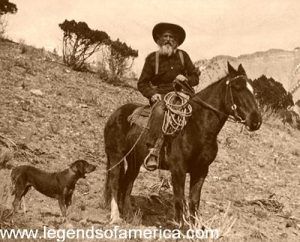
Trapper
When the food in one locality fails, they go to another, and toward fall, when the grass of the high prairies becomes parched by the heat and drought, they gradually work their way back to the south, concentrating on the rich pastures of Texas and the Indian Indian Territory, whence, the same instinct acting on all, they are ready to start together again on their northward march as soon as spring starts the grass.
Old plainsmen and the Indians aver that the buffalo never return south; that each year’s herd was composed of animals which had never made the journey before, and would never make it again. All admit the northern migration, that being too pronounced for any one to dispute, but refuse to admit the southern migration. Thousands of young calves were caught and killed every spring that were produced during this migration, and accompanied the herd northward; but because the buffalo did not return south in one vast body as they went north, it was stoutly maintained that they did not go south at all. The plainsman could give no reasonable hypothesis of his “No-return theory” on which to base the origin of the vast herds which yearly made their march northward. The Indian was, however, equal to the occasion. Every Plains Indian firmly believed that the buffalo were produced in countless numbers in a country under ground; that every spring the surplus swarmed, like bees from a hive, out of the immense cave-like opening in the region of the great Llano Estacado, or Staked Plains of Texas. In 1879 Stone Calf, a celebrated chief, assured me that he knew exactly where the caves were, though he had never seen them; that the good God had provided this means for the constant supply of food for the Indian, and however recklessly the white men might slaughter, they could never exterminate them. When last I saw him, the old man was beginning to waver in this belief, and feared that the “Bad God” had shut the entrances, and that his tribe must starve.”
The old trappers and plainsmen themselves, even as early as the beginning of the Santa Fe trade, noticed the gradual disappearance of the buffalo, while they still existed in countless numbers.
By Henry Inman, 1897. Compiled and edited by Kathy Weiser/Legends of America, updated January 2021.
~~~~~~~~~
By 1900 there were only three hundred buffalo left in the United States. This condition drastically altered the life of the Plains Indians. In 1902, a herd of 41 captive and wild bison was placed under government protection in Yellowstone Park; these animals formed the nucleus of the herd that survives today.
Now, the trend has been reversed and the buffalo live in the wilderness on reservations with the hope that their numbers will increase. They will never reach their former status when they roamed freely over the majestic, windswept Plains. But hopefully, man will be wise enough to protect them from extinction.
~~~~~~~~~
About this article: Excerpted from the book, The Old Santa Fe Trail, by Colonel Henry Inman, 1897. The text as it appears here; however, is not verbatim as it has been edited for clarity and ease of the modern reader. Henry Inman was well known both as an officer in the U.S. Army and an author dealing with subjects of the Western plains. During the Civil War, Inman was a Lieutenant Colonel and afterward, he won distinction as a magazine writer. He wrote several books including his Old Santa Fe Trail, Great Salt Lake Trail, The Ranch on the Ox-hide and other similar books dealing with the subjects he knew so well. Colonel Inman left a number of unfinished manuscripts at his death in Topeka, Kansas on November 13, 1899.
Also See:
Hunting Buffalo With Teddy Roosevelt

